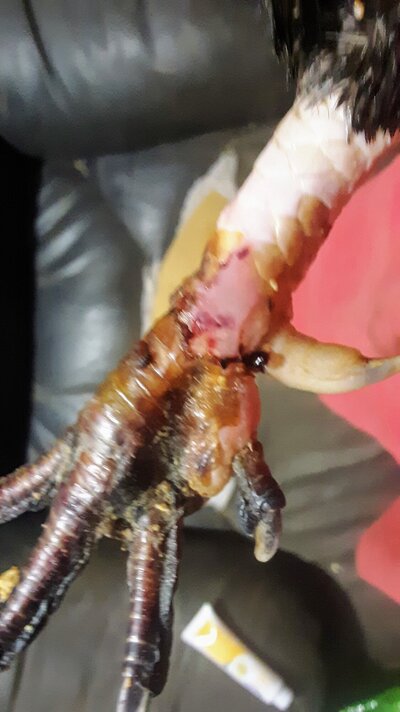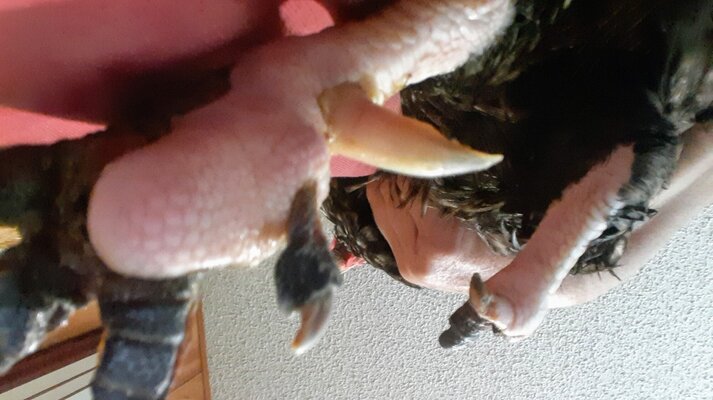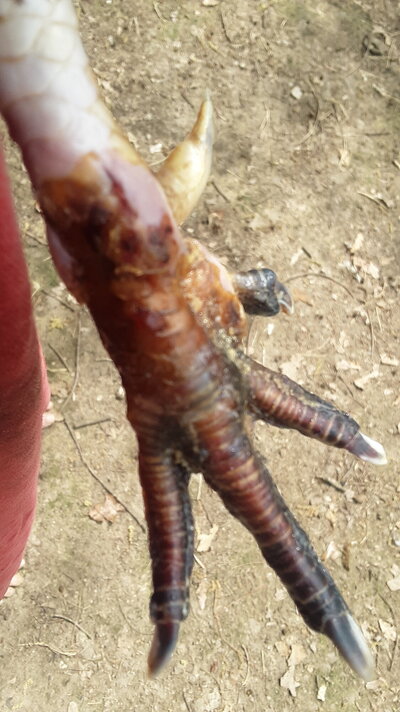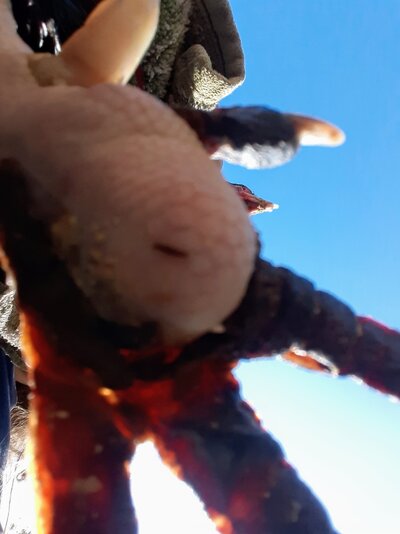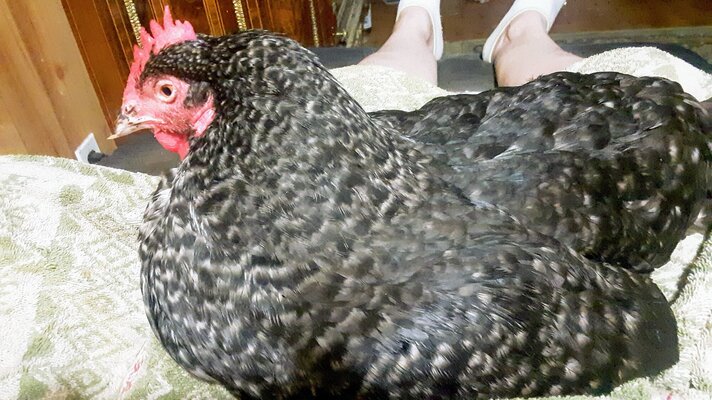- Thread starter
- #121
Navigation
Install the app
How to install the app on iOS
Follow along with the video below to see how to install our site as a web app on your home screen.
Note: This feature may not be available in some browsers.
More options
You are using an out of date browser. It may not display this or other websites correctly.
You should upgrade or use an alternative browser.
You should upgrade or use an alternative browser.
Matilda is going to lose her feet. :(
- Thread starter Allsfairinloveandbugs
- Start date
- Thread starter
- #122
Monday April 12. First photo is underside of foot, with toes pointing southwest. Her right foot has stubbornly refused to let go of its toes, even though the toes are stiff, rigid, blackened, & appear completely necrotic. But the top of the right foot appears more "colorful", with some red color mixed in with the black.
Attachments
I cannot locate the exact thread this picture came from, but the chicken suffered frostbite of a lot of tissue on the feet, and had a lot of damage, but it shows some healthy tissue as well. I remember posting on that thread, but could only locate the picture. Glad that everything is going well with your hen. https://www.backyardchickens.com/content/type/61/id/6088894/width/350/height/700
Ascholten
Free Ranging
Isn't leaving rotten flesh on dangerous? I mean, shouldn't it be removed, so the clean still living stuff can heal up from the amputation point?
Aaron
Aaron
Usually, frostbitten toes will self amputate. It takes time for this to occur, but most chickens survive. It helps to either soak the feet or use a disinfectant such as Betadine or chlorhexidene on them if soaking is not done.Isn't leaving rotten flesh on dangerous? I mean, shouldn't it be removed, so the clean still living stuff can heal up from the amputation point?
Aaron
- Thread starter
- #126
Today, april 13. I stepped outside in the morning sun, to take another picture of the bottom of her right foot. And got my answer as to the status of the foot. The sun and photo angle clearly shows there is a blood supply in Some of her toes. Is that not the coolest photo?! So obviously there is still healing and recovery going on beneath the blackened skin.
I have continued with epsom salt soaks, veterycin spray, & triple antibiotic on both feet. Have left the left nub unwrapped since saturday. I was going to vetwrap the nub this weekend, & take her outside for some sunshine and an attempt at a dustbath. (At the least she could have enjoyed sitting in a dust hole). But after seeing the peeling scales and fresh pink skin on right foot, i thought best to keep her off dirt and not risk infection. So she continues to relax in my lap, & is very content. I still think some fresh air and sunshine would do her good, but gonna be rainy next several days anyway . To sum it up, Matilda is doing great!
I have continued with epsom salt soaks, veterycin spray, & triple antibiotic on both feet. Have left the left nub unwrapped since saturday. I was going to vetwrap the nub this weekend, & take her outside for some sunshine and an attempt at a dustbath. (At the least she could have enjoyed sitting in a dust hole). But after seeing the peeling scales and fresh pink skin on right foot, i thought best to keep her off dirt and not risk infection. So she continues to relax in my lap, & is very content. I still think some fresh air and sunshine would do her good, but gonna be rainy next several days anyway . To sum it up, Matilda is doing great!
Attachments
So happy to hear that she's doing well! I'm curious to see what, if any, toe flesh survives on this foot.
In the meantime, enjoy your new lap chicken. :3
Side note: Is that an underbite I see? Never seen a hen with a longer lower beak than upper. Has she always had that?
In the meantime, enjoy your new lap chicken. :3
Side note: Is that an underbite I see? Never seen a hen with a longer lower beak than upper. Has she always had that?
- Thread starter
- #128
Yes that picture looks much like her right foot, with a mix of black, red & even yellow colors. The photo from this morn of the underside of her right foot shows Exactly what is going on! This morn's photo also caused me to think of pentoxifyline again, & question whether i should have taken her to vet to get a prescription for the med after all, even if very delayed. Also this. Ive already mentioned that when i initially found her hanging upside down and brought her inside, her left foot had some warmth, but the right foot was cold to my touch. I didnt know to warm her feet up in warm water, so instead i held her feet in my hands until i felt them warm. BUT i suspect i focused more on her right foot. That is the foot she hung by, & it is also the foot that felt cold. I will always wonder how her left foot was the one that substained more damage, unless i simply didnt warm it up properly. What is done is done, & im just re-emphasizing the proper way to warm up frostbite cases. Also, if one wants to give a bird's frostbitten feet the Best chance for recovery, a trip to a vet for a basic exam and pentoxiphyline prescript would be a good move. And @Excessive , i think your previous mention of catching your birds trying to roost on a metal garbage can is very important. Added to my list of always dump standing water during a hard freeze, is always make sure my chickens cannot stand, roost or come in contact with bare metal. To those who insisted their birds never got their feet wet but nevertheless suffered severe frostbite, my guess is contact with frozen metal was a cause.I cannot locate the exact thread this picture came from, but the chicken suffered frostbite of a lot of tissue on the feet, and had a lot of damage, but it shows some healthy tissue as well. I remember posting on that thread, but could only locate the picture. Glad that everything is going well with your hen. https://www.backyardchickens.com/content/type/61/id/6088894/width/350/height/700
- Thread starter
- #129
I did a lot of research on Human feet frostbite, since there is much more info re humans. (And the pics are just as ugly). Even with human cases, not much can be done after the initial rewarming . With human toes, neither surgery nor amputation usually takes place unless the the necrotic tissue becomes Wet gangrene. Most necrotic frostbite is due to Dry gangrene. The blackened tissue actually serves to protect from infection any healing that may be taking place, same as the blisters serve as a protective barrier in early frostbite stages. (Meaning frostbite blisters should never be popped or drained). Also, sorry @Eggcessive , i mis -spelled your user name in my prior post.Isn't leaving rotten flesh on dangerous? I mean, shouldn't it be removed, so the clean still living stuff can heal up from the amputation point?
Aaron
- Thread starter
- #130
Yes im curious too. I had wondered why the right toes hadnt already fallen off, especially since they appear black and dead from above. But the photo with the sun shining through clearly shows red, so there is definitely Some blood supply in the toes.So happy to hear that she's doing well! I'm curious to see what, if any, toe flesh survives on this foot.
In the meantime, enjoy your new lap chicken. :3
Side note: Is that an underbite I see? Never seen a hen with a longer lower beak than upper. Has she always had that?
Re Matilda's beak, yes i was curious if anyone had noticed that. She arrived from the hatchery that way, with her top break either broken or "debeaked." The reason i always wondered if someone had practiced "debeaking", or possibly was even just being cruel, is the following: When i got Matilda, at the same time i got 3 other Cuckoo Marans and 6 Gold-sex links. Matilda was a nutcase! She was literally Cuckoo and terrified of me. She would totally freak out and try to escape every time i reached in the brooder to add feed, change water, or clean out shavings. Ive never had a chick react like she did, & have never forgot it. Her fear was so extreme that i ended up separating her and the other marans from the gold sex-links. The sexlinks were calm and friendly, & i didnt want Matilda's terror to influence them. She did settle down with time, especially after she turned 6 months old and hatched her first clutch of chicks. She is of course now completely calm and trusting. It does seem to me her lower beak has grown longer since her injury, so i may need to figure out how to file the lower beak. Or even better, give her a method to file it herself, same as she did when she was living free outside. Any ideas anyone? The fact that her lower beak seems to be growing, (while her upper beak never grows) Has been on my mind.
New posts New threads Active threads
-
Threads with more replies in the last 15 days
-
Open Contest Wildlife Photo Contest
- Started by azurbanclucker
- Replies: 310
-
Open Contest BYC's Springtacular Flower Photos
- Started by HorseGirlAbby
- Replies: 254
-
-
Open Contest Official BYC Caption Contest Photo Submission - Thread #10
- Started by TwoCrows
- Replies: 131
-
Announcement Coming Soon: BYC Extreme Coop Makeover YouTube Series! - April fool's 2024
- Started by Nifty-Chicken
- Replies: 108
-



